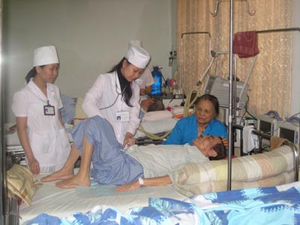More policies come into force today, benefiting people
VGP – Since January 1, 2010, more new regulations regarding people’s life will come into effect.

Since
January 1, 2010, people are issued with new health insurance cards
1. Higher health insurance
contribution

|
Since January 1, 2010, when
patients with health insurance enjoy medical services at their registered clinics,
the health Insurance Fund will pay: |
The Government’s Decree 62/2009/NĐ-CP
instructing the enforcement of the Health Insurance Law stipulates that, since January
1, 2010, the contribution to health insurance will be 4.5% of salary, wage,
retirement pension, or invalidity allowance, and 3% of students’ living wages.
The State budget will
offer subsidiaries equivalent to at least 50% of the contributions of poor
students and 30% from those who are not poor.
Also in 2010, the Việt
Nam Social Insurance will issue new health insurance cards.
All cards issued before January
1, 2010 and still valid in 2010 can be used until the holders leave hospital.
Under the Government’s
Decrees 97/2009/NĐ-CP and 98/2009/NĐ-CP, laborers’ living wages will be
categorized into four different groups of regions having different living
standards.
Accordingly, the
by-region living wages paid for unskilled laborers working in normal conditions
in domestic enterprises will be VND 980,000; 880,000; 810,000; and 730,000 per
month and in FDI enterprises: VND 1,340,000; 1,190,000; 1,040,000; and 1,000,000.
The new monthly wages are
VND 80,000-180,000 higher than the current one.
3. Interest rate
subsidies for medium and long-term loans
The Government decided to
provide interest rate subsidies of 2% per year in 2010 for medium and long-term
Vietnamese currency loans taken from commercial banks in order to serve agriculture-forestry;
fisheries; processing industry; science-technology; purchase and trading in
agro-forestry products, marine products and salt.
The decision aims to promote both growth recovery, economic restructuring, and macro-economic stability.
 |
| Activities to purchase and trade in agro-products are provided with the interest rate subsidies of 2% per year in 2010 |
4. Stock income tax
imposed, import-export tariffs cut
 |
|
|
To realize its WTO
commitment, Việt
The new tariff also combines 64 tax rates into 40 ones.
 |
| Smoking at indoor public sites can be fined VND 50,000-100,000 |
Since January 1, 2010, the
PM’s Decision 1315/2009/QĐ-TTg imposes a strict ban on smoking in classrooms,
kindergartens, clinics, libraries, cinemas, theaters, culture houses, production
workshops and indoor working places, and means of public transport.
Punishments include warnings
and pecuniary penalty of VND 50,000-100,000.
6. Civil servants
pay compensation for their wrongdoings
The Law on State
compensation stipulates that individuals and organizations suffering material
and spiritual damages caused by civil servants in administrative and judicial activities
have right to ask for State compensation. For the first time, a Vietnamese law
clearly defines 11 illegal acts of civil servants, for which the State
compensation are required.
Civil servants who commit
intentional wrongdoings are forced to pay a part of the compensation.
7. Capital
punishment abrogated for some offences
The Law to revise and
supplement some articles of the Penal Code adds new regulations regarding
economic and environment crimes while abrogating capital punishment imposed on
eight offences, namely Rape; Fraudulently misappropriating citizens’ private
property; Smuggling; Forging currencies, concealing or circulating forged
currencies, counterfeit stamps, tickets or papers used in distribution; Organization
of illegal use of drug substances; Forcible takeover of aircraft or ships; Offering
bribe; and Destroying weapons or military equipment.
 |
So far, there are 743
urban areas of all kinds, over 160 concentrated industrial parks, and 28 border-gate
economic zones throughout Việt
The Law on Urban Planning
stipulates that planners, when making urban planning schemes, must collect
opinions of all stakeholders and these schemes must be publicized within 30
days since their approval.
9. Unemployment insurance
paid for laborers
Officially applied since
January 1, 2010, unemployment insurance is compulsory to laborers and
enterprises. Through this kind of insurance, laborers can receive allowance in
case of unemployment and will have chances for vocational training, job
consultancy and health insurance.
Accordingly,
laborers shall contribute 1% of their monthly salary, employers 1% of their
wage fund and the State budget 1%.
Unemployment
pension for laborers is 60% of their average monthly wage paid during six
months before they become unemployed. They can enjoy the pension for a period
of time equivalent to their contributions to unemployment insurance.
By Hồng Hạnh

